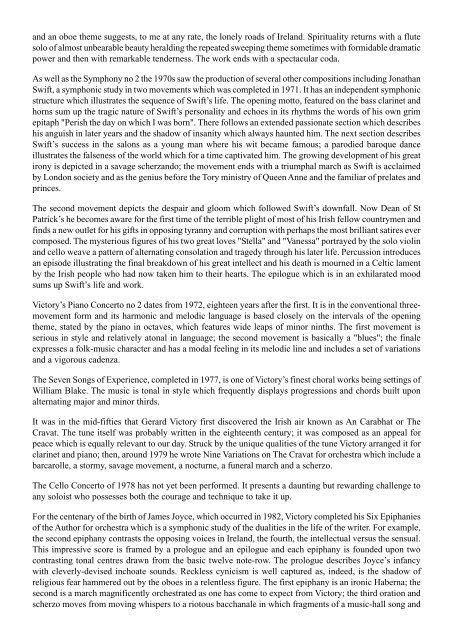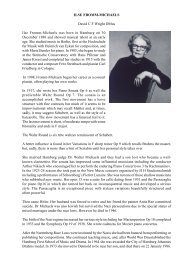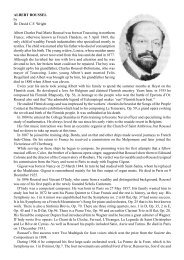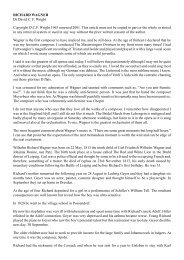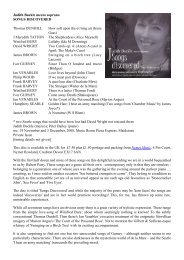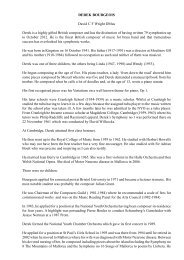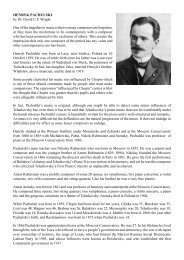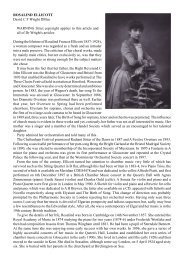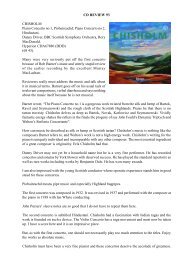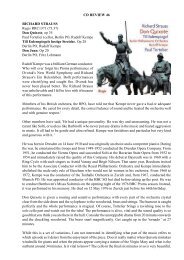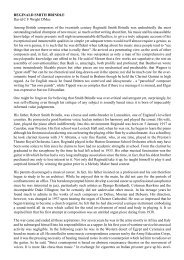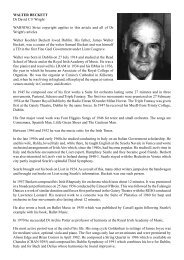Create successful ePaper yourself
Turn your PDF publications into a flip-book with our unique Google optimized e-Paper software.
and an oboe theme suggests, to me at any rate, the lonely roads of Ireland. Spirituality returns with a flute<br />
solo of almost unbearable beauty heralding the repeated sweeping theme sometimes with formidable dramatic<br />
power and then with remarkable tenderness. The work ends with a spectacular coda.<br />
As well as the Symphony no 2 the 1970s saw the production of several other compositions including Jonathan<br />
Swift, a symphonic study in two movements which was completed in 1971. It has an independent symphonic<br />
structure which illustrates the sequence of Swift’s life. The opening motto, featured on the bass clarinet and<br />
horns sum up the tragic nature of Swift’s personality and echoes in its rhythms the words of his own grim<br />
epitaph "Perish the day on which I was born". There follows an extended passionate section which describes<br />
his anguish in later years and the shadow of insanity which always haunted him. The next section describes<br />
Swift’s success in the salons as a young man where his wit became famous; a parodied baroque dance<br />
illustrates the falseness of the world which for a time captivated him. The growing development of his great<br />
irony is depicted in a savage scherzando; the movement ends with a triumphal march as Swift is acclaimed<br />
by London society and as the genius before the Tory ministry of Queen Anne and the familiar of prelates and<br />
princes.<br />
The second movement depicts the despair and gloom which followed Swift’s downfall. Now Dean of St<br />
Patrick’s he becomes aware for the first time of the terrible plight of most of his Irish fellow countrymen and<br />
finds a new outlet for his gifts in opposing tyranny and corruption with perhaps the most brilliant satires ever<br />
composed. The mysterious figures of his two great loves "Stella" and "Vanessa" portrayed by the solo violin<br />
and cello weave a pattern of alternating consolation and tragedy through his later life. Percussion introduces<br />
an episode illustrating the final breakdown of his great intellect and his death is mourned in a Celtic lament<br />
by the Irish people who had now taken him to their hearts. The epilogue which is in an exhilarated mood<br />
sums up Swift’s life and work.<br />
<strong>Victory</strong>’s Piano Concerto no 2 dates from 1972, eighteen years after the first. It is in the conventional threemovement<br />
form and its harmonic and melodic language is based closely on the intervals of the opening<br />
theme, stated by the piano in octaves, which features wide leaps of minor ninths. The first movement is<br />
serious in style and relatively atonal in language; the second movement is basically a "blues"; the finale<br />
expresses a folk-music character and has a modal feeling in its melodic line and includes a set of variations<br />
and a vigorous cadenza.<br />
The Seven Songs of Experience, completed in 1977, is one of <strong>Victory</strong>’s finest choral works being settings of<br />
William Blake. The music is tonal in style which frequently displays progressions and chords built upon<br />
alternating major and minor thirds.<br />
It was in the mid-fifties that <strong>Gerard</strong> <strong>Victory</strong> first discovered the Irish air known as An Carabhat or The<br />
Cravat. The tune itself was probably written in the eighteenth century; it was composed as an appeal for<br />
peace which is equally relevant to our day. Struck by the unique qualities of the tune <strong>Victory</strong> arranged it for<br />
clarinet and piano; then, around 1979 he wrote Nine Variations on The Cravat for orchestra which include a<br />
barcarolle, a stormy, savage movement, a nocturne, a funeral march and a scherzo.<br />
The Cello Concerto of 1978 has not yet been performed. It presents a daunting but rewarding challenge to<br />
any soloist who possesses both the courage and technique to take it up.<br />
For the centenary of the birth of James Joyce, which occurred in 1982, <strong>Victory</strong> completed his Six Epiphanies<br />
of the Author for orchestra which is a symphonic study of the dualities in the life of the writer. For example,<br />
the second epiphany contrasts the opposing voices in Ireland, the fourth, the intellectual versus the sensual.<br />
This impressive score is framed by a prologue and an epilogue and each epiphany is founded upon two<br />
contrasting tonal centres drawn from the basic twelve note-row. The prologue describes Joyce’s infancy<br />
with cleverly-devised inchoate sounds. Reckless cynicism is well captured as, indeed, is the shadow of<br />
religious fear hammered out by the oboes in a relentless figure. The first epiphany is an ironic Haberna; the<br />
second is a march magnificently orchestrated as one has come to expect from <strong>Victory</strong>; the third oration and<br />
scherzo moves from moving whispers to a riotous bacchanale in which fragments of a music-hall song and


